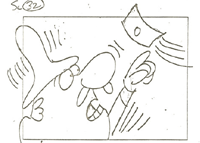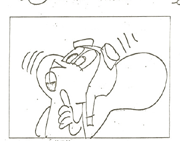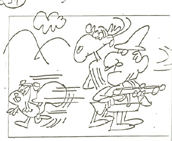We Don't Need No Stink'n Storyboards !
It is amazing to me the number of aspiring artists who want to make cartoons, thanks to the easy access to programs like Flash or Toon Boom Studio, that have the mistaken impression that story boarding is an unnecessary waste of time, unless maybe if you are part of a big studio. Nothing could be farther from the truth.
Not only is the creation of a story board an important part of writing cartoons, it is also one of the pure joys of the process. Now anyone who has ever been involved in producing a cartoon, without regard to its length, has painful, perhaps repressed, memories of what a long tedious, extended, "like watching grass grow" process it can be. In fact, I would venture to say, that more animated cartoon projects fail to be completed because of the overwhelming loss of momentum that results from how long it really takes to produce a finished product then for almost any other reason. That's right, just plain loss of interest, boredom, "off to their next great conquest", "this has gotten old" loss of momentum. If you have never been there, the secret is out of the bag, cartoon production is like any significant project. It starts off with great excitement and it slows to a crawl with the execution. And most projects just plain run out of gas in the middle, if not sooner. So, what can you do to avoid the cartoon maker’s blues?

The first step is to understand and realize that the joy is in the journey not the destination, so you need to mentally be prepared and have the right attitude. It takes a lot more persistence than creativity to be successful. But taking pleasure in the work and all of its many phases helps to keep you focused through the long process. The writing phase which includes story boarding and basic animatic production is not only one of the most creatively important phases, like I said, it is fun.
Let's explore some of the many values to producing a storyboard and an animatic along with a script. The more you write, the easier it gets, and over time the more "visual" your scripts will become. But part of that results from the relatively fast conversion of the written word into actual pictures, the story board. Cartoon writing is iterative, and the steps usually go from written script to initial boards to a combination of revised scripts and boards back and forth until a solid story emerges. Now we find that a combination story board / animatic helps to keep it fresh and alive as well as giving us a sense of "is this working". The story board and the animatic not only act as a quick realization of the initial vision, they also provide a solid reminder of where you are going, along the way, which is comforting during the long production process.

You’re asking "but if I'm a small independent producer do I need this step when I don't have to communicate my vision to others?" Hey, I didn't even mention the story board as a collaboration tool, which is one of its primary purposes. If you are collaborating, you have to have a visual roadmap to use to manage the planning process and to keep everyone on track. But that's just the obvious reason for a story board. The less obvious reasons are the ones I'm discussing here, which are its importance as a reminder of what this long project is all about, and secondly as a safeguard that you don't start too far down the long production road with weak content. It's too much work just to create a really good film, so you sure don't want to do all that and wind up with a "yawn".
With today’s computers and software technology it seems that many aspiring independent producers get so tangled up in the applications that they forget that the delivery of entertaining and interesting content is their goal. Cartoon making is a visual medium but just because it moves doesn’t make it entertaining. The story, the presentation, what I often refer to as the content, is the part that viewers want most. There is a massive glut of visual movement that is passed off as animated cartoons. But to get your work noticed and differentiated and to build an audience you have to be very entertaining. So a solid lesson to be learned is that the pre-production phase is not to be left until your vision is refined into a very entertaining product. What’s the rush? If you rush through or skip past this important work, you may kid yourself that you are producing something, but there is plenty of noise out there already and you are probably just adding to the din.

If your script and storyboards aren’t entertaining why would you think that your end product will improve with age? Most creators know that the zest and energy that goes into the boards is often reduced not improved during production. You can’t count on inspired changes after the fact. Many professionals actually hate to turn loose of the script and the boards because they know that the “watering” down often follows. So even if you have this great idea in your head and you are working by yourself, put it down on paper and visualize it while it is clear. First of all it probably isn’t clear and second of all it’s a long road and you are going to need a solid plan and a well developed vision or you are going to get lost along the way. Oh and did I mention before it’s a lot of fun. If your work isn’t entertaining to you what makes you think it will be to other people. We roll on the floor watching our boards come to life. You want and need that reinforcement because later during the long process you are going to see this stuff over and over endlessly and it won’t be very fresh or new for long. After a while you will start to question if it is entertaining because it becomes so familiar. You need those memories of how funny it was when you did the boards to keep you grounded and confident. Those stink’n story boards and animatics are not obsolete or a waste of time, they are the best technique invented for starting and finishing a cartoon project.
Not only is the creation of a story board an important part of writing cartoons, it is also one of the pure joys of the process. Now anyone who has ever been involved in producing a cartoon, without regard to its length, has painful, perhaps repressed, memories of what a long tedious, extended, "like watching grass grow" process it can be. In fact, I would venture to say, that more animated cartoon projects fail to be completed because of the overwhelming loss of momentum that results from how long it really takes to produce a finished product then for almost any other reason. That's right, just plain loss of interest, boredom, "off to their next great conquest", "this has gotten old" loss of momentum. If you have never been there, the secret is out of the bag, cartoon production is like any significant project. It starts off with great excitement and it slows to a crawl with the execution. And most projects just plain run out of gas in the middle, if not sooner. So, what can you do to avoid the cartoon maker’s blues?

The first step is to understand and realize that the joy is in the journey not the destination, so you need to mentally be prepared and have the right attitude. It takes a lot more persistence than creativity to be successful. But taking pleasure in the work and all of its many phases helps to keep you focused through the long process. The writing phase which includes story boarding and basic animatic production is not only one of the most creatively important phases, like I said, it is fun.
Let's explore some of the many values to producing a storyboard and an animatic along with a script. The more you write, the easier it gets, and over time the more "visual" your scripts will become. But part of that results from the relatively fast conversion of the written word into actual pictures, the story board. Cartoon writing is iterative, and the steps usually go from written script to initial boards to a combination of revised scripts and boards back and forth until a solid story emerges. Now we find that a combination story board / animatic helps to keep it fresh and alive as well as giving us a sense of "is this working". The story board and the animatic not only act as a quick realization of the initial vision, they also provide a solid reminder of where you are going, along the way, which is comforting during the long production process.

You’re asking "but if I'm a small independent producer do I need this step when I don't have to communicate my vision to others?" Hey, I didn't even mention the story board as a collaboration tool, which is one of its primary purposes. If you are collaborating, you have to have a visual roadmap to use to manage the planning process and to keep everyone on track. But that's just the obvious reason for a story board. The less obvious reasons are the ones I'm discussing here, which are its importance as a reminder of what this long project is all about, and secondly as a safeguard that you don't start too far down the long production road with weak content. It's too much work just to create a really good film, so you sure don't want to do all that and wind up with a "yawn".
With today’s computers and software technology it seems that many aspiring independent producers get so tangled up in the applications that they forget that the delivery of entertaining and interesting content is their goal. Cartoon making is a visual medium but just because it moves doesn’t make it entertaining. The story, the presentation, what I often refer to as the content, is the part that viewers want most. There is a massive glut of visual movement that is passed off as animated cartoons. But to get your work noticed and differentiated and to build an audience you have to be very entertaining. So a solid lesson to be learned is that the pre-production phase is not to be left until your vision is refined into a very entertaining product. What’s the rush? If you rush through or skip past this important work, you may kid yourself that you are producing something, but there is plenty of noise out there already and you are probably just adding to the din.

If your script and storyboards aren’t entertaining why would you think that your end product will improve with age? Most creators know that the zest and energy that goes into the boards is often reduced not improved during production. You can’t count on inspired changes after the fact. Many professionals actually hate to turn loose of the script and the boards because they know that the “watering” down often follows. So even if you have this great idea in your head and you are working by yourself, put it down on paper and visualize it while it is clear. First of all it probably isn’t clear and second of all it’s a long road and you are going to need a solid plan and a well developed vision or you are going to get lost along the way. Oh and did I mention before it’s a lot of fun. If your work isn’t entertaining to you what makes you think it will be to other people. We roll on the floor watching our boards come to life. You want and need that reinforcement because later during the long process you are going to see this stuff over and over endlessly and it won’t be very fresh or new for long. After a while you will start to question if it is entertaining because it becomes so familiar. You need those memories of how funny it was when you did the boards to keep you grounded and confident. Those stink’n story boards and animatics are not obsolete or a waste of time, they are the best technique invented for starting and finishing a cartoon project.

0 Comments:
Post a Comment
<< Home